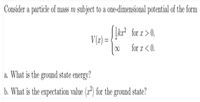Question

Transcribed Image Text:Consider a particle of mass m subject to a one-dimensional potential of the form
kr? for z> 0,
V(2) =
00
for r < 0.
a. What is the ground state energy?
b. What is the expectation value (r*) for the ground state?
Expert Solution
This question has been solved!
Explore an expertly crafted, step-by-step solution for a thorough understanding of key concepts.
This is a popular solution
Trending nowThis is a popular solution!
Step by stepSolved in 2 steps with 1 images

Knowledge Booster
Similar questions
- Q1. Consider the finite square well potential shown in the following diagram: U(x) E>0 L The potential is given by: for xL| -U. for 0 0is incident on this region from the left. Using the plane A particle with energy wave approximation for the particle: a) Show that Y = Ae*+Be¬k* is a suitable general solution to the time-independent Schrödinger wave-equation (TISE) that applies in the region x L write down the four equations arising from the boundary conditions that apply at x=0 and x=L .arrow_forwardA particle is described by the wavefunction Ψ(t, x), and the momentum operator is denoted by pˆ. a) Write down an expression for the differential operator pˆ. b) Write down an expression for the expectation value of the momentum, ⟨p⟩. c) Write down an expression for the probability density, ρ. d) Write down an expression for the probability of finding the particle between x = a and x = b.arrow_forwardA particle of mass m is moving in one-dimension in a potential V (x) with zero energy. The wave function for the particle is Þ(x) = Axe-x²/a? Where A and a are constants a) Use Schrodinger equation to find the potential energy V (x) of the particle. b) Evaluate your answer at x = 0arrow_forward
- Consider the superposition wave function (x) = c sin (πx/a) + d sin (2πx/a). a. Is (x) an acceptable wave function for the particle in the box? b. Is(x) an eigenfunction of the total energy operator Ĥ? c. Is(x) normalized?arrow_forward0 A physical system is described by a two-dimensional vector space with Hamiltonian operator Ĥ given by Ĥ = (_) where a is a constant. At time t = 0, the system is prepared in state (t = 0)) = -i2.5 0 determine the expectation value (Ŝ) at time t = πħ/(4x). O a. 2.17 O b. -2.50 O c. -1.25 O d. 2.50 O e. 5.00 0 (¹). For operator $ = (2 i2.5arrow_forward
arrow_back_ios
arrow_forward_ios